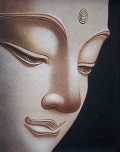May 8, 2023 at 6:00 am
#44711
Keymaster
I just looked at the translation closely. Yes. It can be confusing because he uses “galaxy” to denote a thousand-fold “world system.”
See the side-by-side translation: “Cūḷanikā Sutta (AN 3.80).”
- A “world system” is a single cakkavāla with one star and associated planets. Our Solar system is one.
- At marker 4.3: “cūḷanikā lokadhātu” is a SMALL cluster of a thousand such cakkavāla (incorrectly called a “galaxy.”)
- At marker 5.2: “majjhimikā lokadhātu” is a MEDUIM cluster of a thousand such “cūḷanikā lokadhātu“ (incorrectly called a ” ‘galactic cluster.’”)
- At marker 6.2: “mahāsahassī lokadhātu” is a LARGE cluster of a thousand such “majjhimikā lokadhātu“ (incorrectly called a ” ‘galactic supercluster.’”)
- It is not a good idea to try to match the Buddha’s world systems with the names used by current science. For example, a “galaxy” in current science may have billions of stars like our Sun (i.e., billions of cakkavāla, not just a thousand.) A “mahāsahassī lokadhātu” is within a galaxy. Thus, our “mahāsahassī lokadhātu” is within the Milky Way galaxy.
- The universe has billions of galaxies like our Milky Way galaxy. See “Milky Way“
- Each “mahāsahassī lokadhātu” can have only one Buddha at a time. But there can be Buddhas in other “mahāsahassī lokadhātu” even at this time. The universe is unimaginably vast!
